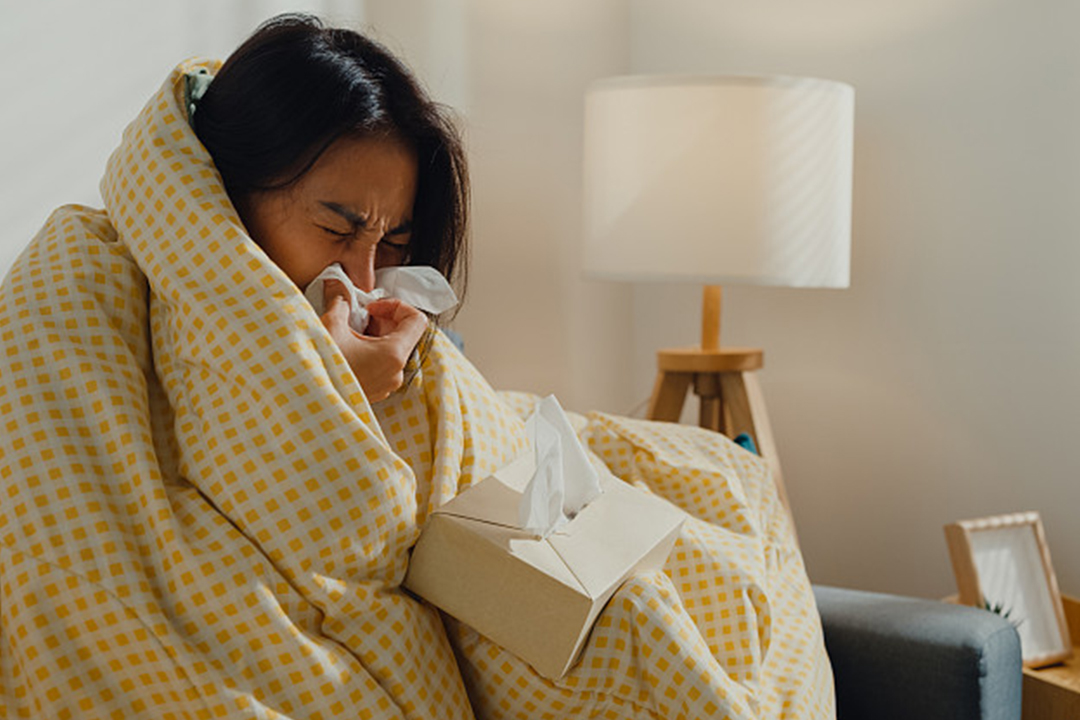Common Cold
What is the common cold?
The common cold is a mild infection of your upper respiratory tract (which includes your nose and throat). Colds are probably the most common illness. Adults have an average of 2-3 colds per year, and children have even more. Colds are more common in the winter and spring, but you can get them at any time.
What causes the common cold?
More than 200 different viruses can cause a cold, but rhinoviruses are the most common type. The viruses that cause colds are very contagious. They can spread from person to person through the air and close personal contact. You can also get infected when you touch something that has the virus on it and then touch your eyes, mouth, or nose. For example, you could get a cold after you shake hands with someone who has a cold or touch a doorknob that has the germs on it, and then touch your face.
What are the symptoms of the common cold?
The symptoms of a common cold usually include:
- Sneezing
- Stuffy nose (congestion)
- Runny nose
- Sore throat
- Coughing
- Headache
The symptoms usually start a few days after you become infected with the virus. Some symptoms can last for 10-14 days.
What are the treatments for the common cold?
There is no cure for the common cold. But there are treatments that can make you feel better while you wait for the cold to go away on its own:
- Getting lots of rest.
- Drinking plenty of fluids.
- Using a clean humidifier or cool mist vaporizer.
- Gargling with warm salt water.
- Using saline nose drops or sprays.
- Taking over-the-counter pain or cold and cough medicines. But you need to be careful with certain medicines:
- Children and teens should not take aspirin.
- Some cold and cough medicines contain ingredients that are not recommended for children. Talk with your child's health care provider before giving your child any cold and cough medicines.
- Some cold and cough medicines contain pain relievers. If you also take a separate pain reliever with these medicines, you could be getting a dangerous amount of the pain reliever. Read the labels on the medicines and follow the instructions carefully. If you have questions, ask your provider or a pharmacist.
Antibiotics will not help with a cold. Antibiotics help with bacterial infections, not with viral infections such as colds.
Most people who have a cold will feel better after a week or two. However, some people who get a cold may develop other illnesses, such as bronchitis or pneumonia. This is more common in people with weakened immune systems, asthma, or other respiratory conditions. Contact your provider if you or your child have symptoms that concern you, such as:
- Trouble breathing or fast breathing
- Dehydration
- Fever that lasts longer than 4 days
- Symptoms that last more than 10 days without improvement
- Symptoms, such as fever or cough, that improve but then return or worsen
- Worsening of chronic medical conditions
Can the common cold be prevented?
There is no vaccine to protect against the common cold. But you may be able to reduce your risk of getting or spreading a cold by:
- Washing your hands often with soap and water for at least 20 seconds.
- Avoiding touching your face, nose, or mouth with unwashed hands.
- Avoiding close contact, such as kissing, shaking hands, and sharing cups and eating utensils, with others if you are sick or they are sick.
- Cleaning and disinfecting surfaces that you frequently touch.
- Covering coughs and sneezes with a tissue. Then throw away the tissue and wash your hands.
- Staying home when sick.

有以下症状说明输卵管中已有积水:
阴道分泌物增多:当积水时,输卵管扩张部与未扩张部分管腔仍在相通,所以患者会有间断性阴道排液。
腰骶部疼痛:患者会有腰骶部疼痛的现象,那是因为炎症的刺激导致的,越严重越明显。
腹痛:小腹疼痛,一般一侧或者严重致两侧疼痛,这是因为输卵管堵塞较为明显。但也有患者没有疼痛感,那是因为积脓变成了浆液性,也就是说积水已经被机体吸收了,自然就不痛了。
发热:严重的患者会发热,这是因为有慢性盆腔炎的表现。因为此症状并不明显,所以大部分病人只有到医院检查才发现。







